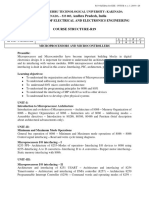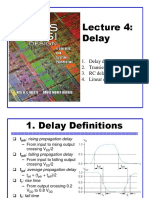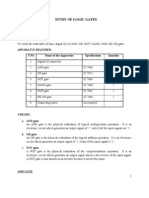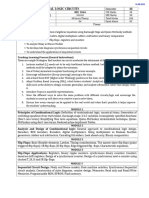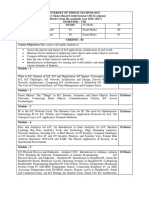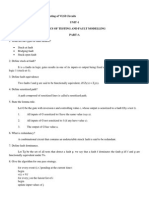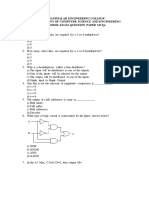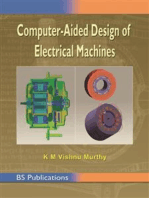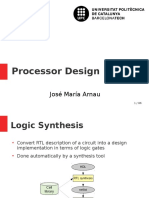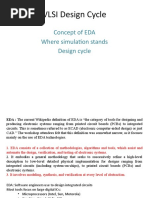DataFlow Modeling in Verilog
DataFlow Modeling in Verilog
Uploaded by
Waqas AhmedCopyright:
Available Formats
DataFlow Modeling in Verilog
DataFlow Modeling in Verilog
Uploaded by
Waqas AhmedOriginal Description:
Copyright
Available Formats
Share this document
Did you find this document useful?
Is this content inappropriate?
Copyright:
Available Formats
DataFlow Modeling in Verilog
DataFlow Modeling in Verilog
Uploaded by
Waqas AhmedCopyright:
Available Formats
UNIVERSITY OF ENGINEERING AND TECHNOLOGY, TAXILA
FACULTY OF TELECOMMUNICATION AND INFORMATION ENGINEERING
COMPUTER ENGINEERING DEPARTMENT
Digital Logic Design
Lab # 09
Dataflow Modeling in Verilog
Dated:
22nd August, 2016 to 26th August, 2016
Semester:
Autumn 2016
Digital Logic Design
Session:-2k15 Computer
Lab Instructor:-Engr. Aamir Arsalan
UNIVERSITY OF ENGINEERING AND TECHNOLOGY, TAXILA
FACULTY OF TELECOMMUNICATION AND INFORMATION ENGINEERING
COMPUTER ENGINEERING DEPARTMENT
Objective:At the end of this lab you should be able to:
Understand Dataflow Level Modeling in Verilog.
Data Flow Modeling:Introduction:For small circuits, the gate-level modeling approach works very well because the number of
gates is limited and the designer can instantiate and connect every gate individually. Also, gate
level modeling is very intuitive to a designer with a basic knowledge of digital logic design.
However, in complex designs the number of gates is very large. Thus, designers can design more
effectively if they concentrate on implementing the function at a level of abstraction higher than
gate level. Dataflow modeling provides a powerful way to implement a design. Verilog allows a
circuit to be designed in terms of the data flow between registers and how a design processes
data rather than instantiation of individual gates.
With gate densities on chips increasing rapidly, dataflow modeling has assumed great
importance. No longer can companies devote engineering resources to handcrafting entire
designs with gates. Currently, automated tools are used to create a gate-level circuit from a
dataflow design description. This process is called logic synthesis. Dataflow modeling has
become a popular design approach as logic synthesis tools have become sophisticated. This
approach allows the designer to concentrate on optimizing the circuit in terms of data flow. For
maximum flexibility in the design process, designers typically use a Verilog description style
that combines the concepts of gate-level, data flow, and behavioral design. In the digital design
community, the term RTL (Register Transfer Level) design is commonly used for a combination
of dataflow modeling and behavioral modeling.
Continuous Assignments:A continuous assignment is the most basic statement in dataflow modeling, used to drive a value
onto a net. This assignment replaces gates in the description of the circuit and describes the
circuit at a higher level of abstraction. The assignment statement starts with the keyword assign.
The syntax of an assign statement is as follows.
continuous_assign:: = assign list_of_net_assignments ;
list_of_net_assignments:: = net_assignment {, net_assignment}
net_assignment::= net_lvalue = expression
Digital Logic Design
Session:-2k15 Computer
Lab Instructor:-Engr. Aamir Arsalan
UNIVERSITY OF ENGINEERING AND TECHNOLOGY, TAXILA
FACULTY OF TELECOMMUNICATION AND INFORMATION ENGINEERING
COMPUTER ENGINEERING DEPARTMENT
Continuous assignments have the following characteristics: The left hand side of an assignment must always be a scalar or vector net or a
concatenation of scalar and vector nets. It cannot be a scalar or vector register.
Continuous assignments are always active. The assignment expression is evaluated a
soon as one of the right-hand-side operands changes and the value is assigned to the lefthand-side net.
The operands on the right-hand side can be registers or nets or function calls. Registers or
nets can be scalars or vectors.
Examples of continuous assignments are shown below. Operators such as &, ^, |, {, } and + used
in the examples will be explained a little later. At this point, concentrate on how the assign
statements are specified.
Examples of Continuous Assignment:// Continuous assign. out is a net. i1 and i2 are nets.
assign out = i1 & i2;
// Continuous assign for vector nets. addr is a 16-bit vector
net addr1 and addr2 are 16-bit //vector registers.
assign addr[15:0] = addr1_bits[15:0] ^ addr2_bits[15:0];
// Concatenation. Left-hand side is a concatenation of a scalar
net and a vector net.
assign {c_out, sum[3:0]} = a[3:0] + b[3:0] + c_in;
Implicit Continuous Assignment:Instead of declaring a net and then writing a continuous assignment on the net, Verilog provides
a shortcut by which a continuous assignment can be placed on a net when it is declared. There
can be only one implicit declaration assignment per net because a net is declared only once.
In the example below, an implicit continuous assignment is contrasted with a regular continuous
assignment.
//Regular continuous assignment
wire out;
assign out = in1 & in2;
//Same effect is achieved by an implicit continuous assignment
wire out = in1 & in2;
Digital Logic Design
Session:-2k15 Computer
Lab Instructor:-Engr. Aamir Arsalan
UNIVERSITY OF ENGINEERING AND TECHNOLOGY, TAXILA
FACULTY OF TELECOMMUNICATION AND INFORMATION ENGINEERING
COMPUTER ENGINEERING DEPARTMENT
Implicit Net Declaration:If a signal name is used to the left of the continuous assignment, an implicit net declaration will
be inferred for that signal name. If the net is connected to a module port, the width of the inferred
net is equal to the width of the module port.
// Continuous assign. out is a net.
wire i1, i2;
assign out = i1 & i2; //Note that out was not declared as a wire
but an implicit wire declaration for out is done by the
simulator.
Let us take a closer look at expressions, operators, and operands that are used inside continuous
assignments.
Expressions, Operators, and Operands:Dataflow modeling describes the design in terms of expressions instead of primitive gates.
Expressions, operators, and operands form the basis of dataflow modeling.
Expressions:Expressions are constructs that combine operators and operands to produce a result.
// Examples of expressions. Combines operands and operators
a ^ b
addr1[20:17] + addr2[20:17]
in1 | in2
Operands:Operands can be any one of the data types defined. Some constructs will take only certain types
of operands. Operands can be constants, integers, real numbers, nets, registers, times, bit-select
(one bit of vector net or a vector register), part-select (selected bits of the vector net or register
vector), and memories or function calls (functions are discussed later).
integer count, final_count;
final_count = count + 1;//count is an integer operand
real a, b, c;
c = a - b; //a and b are real operands
Digital Logic Design
Session:-2k15 Computer
Lab Instructor:-Engr. Aamir Arsalan
UNIVERSITY OF ENGINEERING AND TECHNOLOGY, TAXILA
FACULTY OF TELECOMMUNICATION AND INFORMATION ENGINEERING
COMPUTER ENGINEERING DEPARTMENT
reg [15:0] reg1, reg2;
reg [3:0] reg_out;
reg_out = reg1[3:0] ^ reg2[3:0];//reg1[3:0] and reg2[3:0] are
//part-select register operands
reg ret_value;
ret_value = calculate_parity(A, B);//calculate_parity is a
function type operand.
Operators:Operators act on the operands to produce desired results. Verilog provides various types of
operators. Operator types are discussed in detail next.
d1 && d2 // && is an operator on operands d1 and d2
!a[0] // ! is an operator on operand a[0]
B >> 1 // >> is an operator on operands B and 1.
Operator Types:Verilog provides many different operator types. Operators can be arithmetic, logical, relational,
equality, bitwise, reduction, shift, concatenation, or conditional. Some of these operators are
similar to the operators used in the C programming language. Each operator type is denoted by a
symbol. Table below shows the complete listing of operator symbols classified by category.
Operator Type
Operator Symbol
Arithmetic
Logical
Digital Logic Design
Session:-2k15 Computer
Operation
Performed
multiply
Number of
Operands
two
divide
two
add
two
subtract
two
modulus
two
**
!
power (exponent)
logical negation
two
one
&&
logical and
two
||
logical or
two
Lab Instructor:-Engr. Aamir Arsalan
UNIVERSITY OF ENGINEERING AND TECHNOLOGY, TAXILA
FACULTY OF TELECOMMUNICATION AND INFORMATION ENGINEERING
COMPUTER ENGINEERING DEPARTMENT
Relational
Equality
Bitwise
Reduction
Shift
Digital Logic Design
Session:-2k15 Computer
>
greater than
two
<
less than
two
>=
greater than or equal
two
<=
==
less than or equal
equality
two
two
!=
inequality
two
===
case equality
two
!==
~
case inequality
bitwise negation
two
one
&
bitwise and
two
bitwise or
two
bitwise xor
two
^~ or ~^
&
bitwise xnor
reduction and
two
one
~&
reduction nand
one
reduction or
one
~|
reduction nor
one
reduction xor
one
^~ or ~^
>>
reduction xnor
Right shift
one
Two
<<
Left shift
Two
>>>
Arithmetic right shift
Two
<<<
Arithmetic left shift
Two
Lab Instructor:-Engr. Aamir Arsalan
UNIVERSITY OF ENGINEERING AND TECHNOLOGY, TAXILA
FACULTY OF TELECOMMUNICATION AND INFORMATION ENGINEERING
COMPUTER ENGINEERING DEPARTMENT
Concatenation
Replication
Conditional
{}
{{}}
?:
Concatenation
Replication
Conditional
Any Number
Any Number
Three
Let us now discuss each operator type in detail.
Arithmetic Operators:There are two types of arithmetic operators: binary and unary.
Binary operators:Binary arithmetic operators are multiply (*), divide (/), add (+), subtract (-), power (**), and
modulus (%). Binary operators take two operands.
A = 4'b0011; B = 4'b0100; // A and B are register vectors
D = 6; E = 4; F=2// D and E are integers
A * B
D / E
part.
A + B
B - A
F = E
// Multiply A and B. Evaluates to 4'b1100
// Divide D by E. Evaluates to 1. Truncates any fractional
// Add A and B. Evaluates to 4'b0111
// Subtract A from B. Evaluates to 4'b0001
** F; //E to the power F, yields 16
If any operand bit has a value x, then the result of the entire expression is x. This seems intuitive
because if an operand value is not known precisely, the result should be an unknown.
in1 = 4'b101x;
in2 = 4'b1010;
sum = in1 + in2; // sum will be evaluated to the value 4'bx
Modulus operators produce the remainder from the division of two numbers. They operate
similarly to the modulus operator in the C programming language.
13 % 3
16 % 4
-7 % 2
7 % -2
//
//
//
//
Evaluates
Evaluates
Evaluates
Evaluates
Digital Logic Design
Session:-2k15 Computer
to
to
to
to
1
0
-1, takes sign of the first operand
+1, takes sign of the first operand.
Lab Instructor:-Engr. Aamir Arsalan
UNIVERSITY OF ENGINEERING AND TECHNOLOGY, TAXILA
FACULTY OF TELECOMMUNICATION AND INFORMATION ENGINEERING
COMPUTER ENGINEERING DEPARTMENT
Unary operators:The operators + and - can also work as unary operators. They are used to specify the positive or
negative sign of the operand. Unary + or operators have higher precedence than the binary + or
operators.
-4 // Negative 4
+5 // Positive 5
Negative numbers are represented as 2's complement internally in Verilog. It is advisable to use
negative numbers only of the type integer or real in expressions. Designers should avoid negative
numbers of the type <sss> '<base> <nnn> in expressions because they are converted to unsigned
2's complement numbers and hence yield unexpected results.
//Advisable to use integer or real numbers
-10 / 5// Evaluates to -2
//Do not use numbers of type <sss> '<base> <nnn>
-'d10 / 5// is equivalent (2's complement of 10)/5 = (232 - 10)/5
// where 32 is the default machine word width.
// This evaluates to an incorrect and unexpected result.
Logical Operators:Logical operators are logical-and (&&), logical-or (||) and logical-not (!). Operators && and ||
are binary operators. Operator ! is a unary operator. Logical operators follow these conditions:
1. Logical operators always evaluate to a 1-bit value, 0 (false), 1 (true), or x (ambiguous).
2. If an operand is not equal to zero, it is equivalent to a logical 1 (true condition). If it is
01equal to zero, it is equivalent to a logical 0 (false condition). If any operand bit is x or
z, it is equivalent to x (ambiguous condition) and is normally treated by simulators as a
false condition.
3. Logical operators take variables or expressions as operands.
Use of parentheses to group logical operations is highly recommended to improve readability.
Also, the user does not have to remember the precedence of operators.
// Logical operations
A = 3; B = 0;
A && B // Evaluates to 0. Equivalent to (logical-1 && logical-0)
A || B // Evaluates to 1. Equivalent to (logical-1 || logical-0)
!A// Evaluates to 0. Equivalent to not(logical-1)
Digital Logic Design
Session:-2k15 Computer
Lab Instructor:-Engr. Aamir Arsalan
UNIVERSITY OF ENGINEERING AND TECHNOLOGY, TAXILA
FACULTY OF TELECOMMUNICATION AND INFORMATION ENGINEERING
COMPUTER ENGINEERING DEPARTMENT
!B// Evaluates to 1. Equivalent to not(logical-0)
// Unknowns
A = 2'b0x; B = 2'b10;
A && B // Evaluates to x. Equivalent to (x && logical 1)
// Expressions
(a == 2) && (b == 3) // Evaluates to 1 if both a == 2 and b == 3
are true.
// Evaluates to 0 if either is false.
Relational Operators:Relational operators are greater-than (>), less-than (<), greater-than-or-equal-to (>=), and lessthan-or-equal-to (<=). If relational operators are used in an expression, the expression returns a
logical value of 1 if the expression is true and 0 if the expression is false. If there are any
unknown or z bits in the operands, the expression takes a value x. These operators function
exactly as the corresponding operators in the C programming language.
// A = 4, B = 3
// X = 4'b1010, Y = 4'b1101, Z = 4'b1xxx
A
A
Y
Y
<= B // Evaluates to a logical 0
> B // Evaluates to a logical 1
>= X // Evaluates to a logical 1
< Z // Evaluates to an x
Equality Operators:Equality operators are logical equality (==), logical inequality (!=), case equality (===), and case
inequality (!==). When used in an expression, equality operators return logical value 1 if true, 0
if false. These operators compare the two operands bit by bit, with zero filling if the operands are
of unequal length. Table below lists the operators.
Digital Logic Design
Session:-2k15 Computer
Lab Instructor:-Engr. Aamir Arsalan
UNIVERSITY OF ENGINEERING AND TECHNOLOGY, TAXILA
FACULTY OF TELECOMMUNICATION AND INFORMATION ENGINEERING
COMPUTER ENGINEERING DEPARTMENT
It is important to note the difference between the logical equality operators (==, !=) and case
equality operators (===, !==). The logical equality operators (==, !=) will yield an x if either
operand has x or z in its bits. However, the case equality operators ( ===, !== ) compare both
operands bit by bit and compare all bits, including x and z. The result is 1 if the operands match
exactly, including x and z bits. The result is 0 if the operands do not match exactly. Case equality
operators never result in an x.
// A = 4, B = 3
// X = 4'b1010, Y = 4'b1101
// Z = 4'b1xxz, M = 4'b1xxz, N = 4'b1xxx
A == B // Results in logical 0
X != Y // Results in logical 1
X == Z // Results in x
Z === M // Results in logical 1 (all bits match, including x and
z)
Z === N // Results in logical 0 (least significant bit does not
match)
M !== N // Results in logical 1.
Bitwise Operators:Bitwise operators are negation (~), and(&), or (|), xor (^), xnor (^~, ~^). Bitwise operators
perform a bit-by-bit operation on two operands. They take each bit in one operand and perform
the operation with the corresponding bit in the other operand. If one operand is shorter than the
other, it will be bit-extended with zeros to match the length of the longer operand. Logic tables
for the bit-by-bit computation are shown in Table below. A z is treated as an x in a bitwise
operation. The exception is the unary negation operator (~), which takes only one operand and
operates on the bits of the single operand.
Examples of bitwise operators are shown below.
// X = 4'b1010, Y = 4'b1101
// Z = 4'b10x1
~X
X & Y
X | Y
X ^ Y
X ^~ Y
//
//
//
//
//
Negation. Result is 4'b0101
Bitwise and. Result is 4'b1000
Bitwise or. Result is 4'b1111
Bitwise xor. Result is 4'b0111
Bitwise xnor. Result is 4'b1000
Digital Logic Design
Session:-2k15 Computer
Lab Instructor:-Engr. Aamir Arsalan
UNIVERSITY OF ENGINEERING AND TECHNOLOGY, TAXILA
FACULTY OF TELECOMMUNICATION AND INFORMATION ENGINEERING
COMPUTER ENGINEERING DEPARTMENT
X & Z
// Result is 4'b10x0
It is important to distinguish bitwise operators ~, &, and | from logical operators !, &&, ||.
Logical operators always yield a logical value 0, 1, x, whereas bitwise operators yield a bit-by-bit
value. Logical operators perform a logical operation, not a bit-by-bit operation.
// X = 4'b1010, Y = 4'b0000
X | Y // bitwise operation. Result is 4'b1010
X || Y // logical operation. Equivalent to 1 || 0. Result is 1.
Reduction Operators:Reduction operators are and (&), nand (~&), or (|), nor (~|), xor (^), and xnor (~^, ^~). Reduction
operators take only one operand. Reduction operators perform a bitwise operation on a single
vector operand and yield a 1-bit result. The logic tables for the operators are the same as shown
Digital Logic Design
Session:-2k15 Computer
Lab Instructor:-Engr. Aamir Arsalan
UNIVERSITY OF ENGINEERING AND TECHNOLOGY, TAXILA
FACULTY OF TELECOMMUNICATION AND INFORMATION ENGINEERING
COMPUTER ENGINEERING DEPARTMENT
above. The difference is that bitwise operations are on bits from two different operands, whereas
reduction operations are on the bits of the same operand. Reduction operators work bit by bit
from right to left. Reduction nand, reduction nor, and reduction xnor are computed by inverting
the result of the reduction and, reduction or, and reduction xor, respectively.
// X = 4'b1010
&X //Equivalent to 1 & 0 & 1 & 0. Results in 1'b0
|X//Equivalent to 1 | 0 | 1 | 0. Results in 1'b1
^X//Equivalent to 1 ^ 0 ^ 1 ^ 0. Results in 1'b0
//A reduction xor or xnor can be used for even or odd parity
//generation of a vector.
The use of a similar set of symbols for logical (!, &&, ||), bitwise (~, &, |, ^), and reduction
operators (&, |, ^) is somewhat confusing initially. The difference lies in the number of operands
each operator takes and also the value of results computed.
Shift Operators:Shift operators are right shift ( >>), left shift (<<), arithmetic right shift (>>>), and arithmetic left
shift (<<<). Regular shift operators shift a vector operand to the right or the left by a specified
number of bits. The operands are the vector and the number of bits to shift. When the bits are
shifted, the vacant bit positions are filled with zeros. Shift operations do not wrap around.
Arithmetic shift operators use the context of the expression to determine the value with which to
fill the vacated bits.
// X = 4'b1100
Y = X >> 1; //Y is 4'b0110. Shift right 1 bit. 0 filled in MSB
position.
Y = X << 1; //Y is 4'b1000. Shift left 1 bit. 0 filled in LSB
position.
Y = X << 2; //Y is 4'b0000. Shift left 2 bits.
integer a, b, c; //Signed data types
a = 0;
b = -10; // 00111...10110 binary
c = a + (b >>> 3); //Results in -2 decimal, due to arithmetic
shift
Shift operators are useful because they allow the designer to model shift operations, shift-andadd algorithms for multiplication, and other useful operations.
Digital Logic Design
Session:-2k15 Computer
Lab Instructor:-Engr. Aamir Arsalan
UNIVERSITY OF ENGINEERING AND TECHNOLOGY, TAXILA
FACULTY OF TELECOMMUNICATION AND INFORMATION ENGINEERING
COMPUTER ENGINEERING DEPARTMENT
Concatenation Operator:The concatenation operator ( {, } ) provides a mechanism to append multiple operands. The
operands must be sized. Unsized operands are not allowed because the size of each operand must
be known for computation of the size of the result.
Concatenations are expressed as operands within braces, with commas separating the operands.
Operands can be scalar nets or registers, vector nets or registers, bit-select, part-select, or sized
constants.
// A = 1'b1, B = 2'b00, C = 2'b10, D = 3'b110
Y = {B , C} // Result Y is 4'b0010
Y = {A , B , C , D , 3'b001} // Result Y is 11'b10010110001
Y = {A , B[0], C[1]} // Result Y is 3'b101
Replication Operator:Repetitive concatenation of the same number can be expressed by using a replication constant. A
replication constant specifies how many times to replicate the number inside the brackets ( { } ).
reg
reg
reg
A =
A;
[1:0] B, C;
[2:0] D;
1'b1; B = 2'b00; C = 2'b10; D = 3'b110;
Y = { 4{A} } // Result Y is 4'b1111
Y = { 4{A} , 2{B} } // Result Y is 8'b11110000
Y = { 4{A} , 2{B} , C } // Result Y is 8'b1111000010
Conditional Operator:The conditional operator (?:) takes three operands.
Usage: condition_expr ? true_expr : false_expr ;
The condition expression (condition_expr) is first evaluated. If the result is true (logical 1), then
the true_expr is evaluated. If the result is false (logical 0), then the false_expr is evaluated. If the
result is x (ambiguous), then both true_expr and false_expr are evaluated and their results are
compared, bit by bit, to return for each bit position an x if the bits are different and the value of
the bits if they are the same.
Digital Logic Design
Session:-2k15 Computer
Lab Instructor:-Engr. Aamir Arsalan
UNIVERSITY OF ENGINEERING AND TECHNOLOGY, TAXILA
FACULTY OF TELECOMMUNICATION AND INFORMATION ENGINEERING
COMPUTER ENGINEERING DEPARTMENT
The action of a conditional operator is similar to a multiplexer. Alternately, it can be compared to
the if-else expression.
Conditional operators are frequently used in dataflow modeling to model conditional
assignments. The conditional expression acts as a switching control.
//model functionality of a tristate buffer
assign addr_bus = drive_enable ? addr_out : 36'bz;
//model functionality of a 2-to-1 mux
assign out = control ? in1 : in0;
Conditional operations can be nested. Each true_expr or false_expr can itself be a conditional
operation. In the example that follows, convince yourself that (A==3) and control are the two
select signals of 4-to-1 multiplexer with n, m, y, x as the inputs and out as the output signal.
assign out = (A == 3) ? (control ? x : y ): ( control ? m : n) ;
Operator Precedence:Having discussed the operators, it is now important to discuss operator precedence. If no
parentheses are used to separate parts of expressions, Verilog enforces the following precedence.
Operators listed in Table below are in order from highest precedence to lowest precedence. It is
recommended that parentheses be used to separate expressions except in case of unary operators
or when there is no ambiguity.
Digital Logic Design
Session:-2k15 Computer
Lab Instructor:-Engr. Aamir Arsalan
UNIVERSITY OF ENGINEERING AND TECHNOLOGY, TAXILA
FACULTY OF TELECOMMUNICATION AND INFORMATION ENGINEERING
COMPUTER ENGINEERING DEPARTMENT
Examples:A design can be represented in terms of gates, data flow, or a behavioral description. In this
section, we consider the 4-to-1 multiplexer and 4-bit full adder using data flow modeling and
compare it to gate level modeling.
Logic Diagram of a multiplexer is given below:-
Digital Logic Design
Session:-2k15 Computer
Lab Instructor:-Engr. Aamir Arsalan
UNIVERSITY OF ENGINEERING AND TECHNOLOGY, TAXILA
FACULTY OF TELECOMMUNICATION AND INFORMATION ENGINEERING
COMPUTER ENGINEERING DEPARTMENT
Verilog Description using Gate level Modeling:// Module 4-to-1 multiplexer. Port list is taken exactly from
// the I/O diagram.
module mux4_to_1 (out, i0, i1, i2, i3, s1, s0);
// Port declarations from the I/O diagram
output out;
input i0, i1, i2, i3;
input s1, s0;
// Internal wire declarations
wire s1n, s0n;
wire y0, y1, y2, y3;
// Gate instantiations
// Create s1n and s0n signals.
not (s1n, s1);
not (s0n, s0);
// 3-input and gates instantiated
and (y0, i0, s1n, s0n);
and (y1, i1, s1n, s0);
and (y2, i2, s1, s0n);
and (y3, i3, s1, s0);
// 4-input or gate instantiated
or (out, y0, y1, y2, y3);
endmodule
We describe the multiplexer, using dataflow statements. Compare it with the gate-level
description. We show two methods to model the multiplexer by using dataflow statements.
Verilog Description using Dataflow level Modeling:Method 1: Logic Equation:-
Digital Logic Design
Session:-2k15 Computer
Lab Instructor:-Engr. Aamir Arsalan
UNIVERSITY OF ENGINEERING AND TECHNOLOGY, TAXILA
FACULTY OF TELECOMMUNICATION AND INFORMATION ENGINEERING
COMPUTER ENGINEERING DEPARTMENT
We can use assignment statements instead of gates to model the logic equations of the
multiplexer. Notice that everything is same as the gate-level Verilog description except that
computation of out is done by specifying one logic equation by using operators instead of
individual gate instantiations. I/O ports remain the same. This is important so that the interface
with the environment does not change. Only the internals of the module change. Notice how
concise the description is compared to the gate-level description.
// Module 4-to-1 multiplexer using data flow using logic equation:// Compare to gate-level model
module mux4_to_1 (out, i0, i1, i2, i3, s1, s0);
// Port declarations from the I/O diagram
output out;
input i0, i1, i2, i3;
input s1, s0;
//Logic equation for out
assign out =
(~s1 & ~s0 & i0)|
(~s1 & s0 & i1) |
(s1 & ~s0 & i2) |
(s1 & s0 & i3) ;
endmodule
Method 2: Conditional Operator:There is a more concise way to specify the 4-to-1 multiplexers. In Conditional Operator section,
we described how a conditional statement corresponds to a multiplexer operation. We will use
this operator to write a 4-to-1 multiplexer.
4-to-1 Multiplexer, Using Conditional Operators:// Module 4-to-1 multiplexer using data flow. Conditional
operator.
// Compare to gate-level model
module multiplexer4_to_1 (out, i0, i1, i2, i3, s1, s0);
// Port declarations from the I/O diagram
output out;
input i0, i1, i2, i3;
input s1, s0;
// Use nested conditional operator
assign out = s1 ? ( s0 ? i3 : i2) : (s0 ? i1 : i0) ;
Digital Logic Design
Session:-2k15 Computer
Lab Instructor:-Engr. Aamir Arsalan
UNIVERSITY OF ENGINEERING AND TECHNOLOGY, TAXILA
FACULTY OF TELECOMMUNICATION AND INFORMATION ENGINEERING
COMPUTER ENGINEERING DEPARTMENT
endmodule
4-bit Full Adder:The logic diagrams of one bit and 4 bit full adder is shown below.
Below is the Verilog code using gate level description.
Verilog Description for 1-bit Full Adder:// Define a 1-bit full adder*
module fulladd(sum, c_out, a, b, c_in);
// I/O port declarations
output sum, c_out;
input a, b, c_in;
// Internal nets
wire s1, c1, c2;
Digital Logic Design
Session:-2k15 Computer
Lab Instructor:-Engr. Aamir Arsalan
UNIVERSITY OF ENGINEERING AND TECHNOLOGY, TAXILA
FACULTY OF TELECOMMUNICATION AND INFORMATION ENGINEERING
COMPUTER ENGINEERING DEPARTMENT
// Instantiate logic gate primitives
xor (s1, a, b);
and (c1, a, b);
xor (sum, s1, c_in);
and (c2, s1, c_in);
xor
(c_out, c2, c1);
endmodule
Verilog Description for 4-bit Ripple Carry Full Adder:// Define a 4-bit full adder
module fulladd4(sum, c_out, a, b, c_in);
// I/O port declarations
output [3:0] sum;
output c_out;
input[3:0] a, b;
input c_in;
// Internal nets
wire c1, c2, c3;
// Instantiate four
fulladd fa0(sum[0],
fulladd fa1(sum[1],
fulladd fa2(sum[2],
fulladd fa3(sum[3],
1-bit full adders.
c1, a[0], b[0], c_in);
c2, a[1], b[1], c1);
c3, a[2], b[2], c2);
c_out, a[3], b[3], c3);
endmodule
4-bit Full Adder, Using Dataflow Operators:module fulladd4(sum, c_out, a, b, c_in);
// Inputs and outputs
output [3:0] sum;
output c_out;
input [3:0] a,b;
input c_in;
// Internal wires
wire p0,g0, p1,g1, p2,g2, p3,g3;
wire c4, c3, c2, c1;
Digital Logic Design
Session:-2k15 Computer
Lab Instructor:-Engr. Aamir Arsalan
UNIVERSITY OF ENGINEERING AND TECHNOLOGY, TAXILA
FACULTY OF TELECOMMUNICATION AND INFORMATION ENGINEERING
COMPUTER ENGINEERING DEPARTMENT
// compute the p
assign p0 = a[0]
p1 = a[1]
p2 = a[2]
p3 = a[3]
for each stage
^ b[0],
^ b[1],
^ b[2],
^ b[3];
// compute the g
assign g0 = a[0]
g1 = a[1]
g2 = a[2]
g3 = a[3]
for each stage
& b[0],
& b[1],
& b[2],
& b[3];
// compute the carry for each stage
// Note that c_in is equivalent c0 in
for
// carry lookahead computation
assign c1 = g0 | (p0 & c_in),
c2 = g1 | (p1 & g0) | (p1 & p0
c3 = g2 | (p2 & g1) | (p2 & p1
c_in),
c4 = g3 | (p3 & g2) | (p3 & p2
g0) |
(p3 &
// Compute Sum
assign sum[0] = p0 ^ c_in,
sum[1] = p1 ^ c1,
sum[2] = p2 ^ c2,
sum[3] = p3 ^ c3;
the arithmetic equation
& c_in),
& g0) | (p2 & p1 & p0 &
& g1) | (p3 & p2 & p1 &
p2 & p1 & p0 & c_in);
// Assign carry output
assign c_out = c4;
endmodule
Lab Task:A full subtractor has three 1-bit inputs x, y, and z (previous
borrow) and two 1-bit outputs D (difference) and B (borrow). The
logic equations for D and B are as follows:
D = x'.y'.z + x'.y.z' + x.y'.z' + x.y.z
Digital Logic Design
Session:-2k15 Computer
Lab Instructor:-Engr. Aamir Arsalan
UNIVERSITY OF ENGINEERING AND TECHNOLOGY, TAXILA
FACULTY OF TELECOMMUNICATION AND INFORMATION ENGINEERING
COMPUTER ENGINEERING DEPARTMENT
B = x'.y + x'.z +y.z
Write the full Verilog description for the full subtractor
module using data flow modeling, including I/O ports. (Remember
that + in logic equations corresponds to a logical or operator
(||) in dataflow).Truth Table is given below:-
A magnitude comparator checks if one number is greater than or
equal to or less than another number. A 4-bit magnitude
comparator takes two 4-bit numbers, A and B, as input. We write
the bits in A and B as follows. The leftmost bit is the most
significant bit.
A = A(3) A(2) A(1) A(0)
B = B(3) B(2) B(1) B(0)
The magnitude can be compared by comparing the numbers bit by
bit, starting with the most significant bit. If any bit
mismatches, the number with bit 0 is the lower number. To
realize this functionality in logic equations, let us define an
intermediate variable. Notice that the function below is an xnor
function.
x(i) = A(i).B(i) + A(i)'.B(i)'
The three outputs of the magnitude comparator are A_gt_B,
A_lt_B, A_eq_B. They are defined with the following logic
equations:
A_gt_B = A(3).B(3)' + x(3).A(2).B(2)' + x(3).x(2).A(1).B(1)' +
x(3).x(2).x(1).A(0).B(0)'
Digital Logic Design
Session:-2k15 Computer
Lab Instructor:-Engr. Aamir Arsalan
UNIVERSITY OF ENGINEERING AND TECHNOLOGY, TAXILA
FACULTY OF TELECOMMUNICATION AND INFORMATION ENGINEERING
COMPUTER ENGINEERING DEPARTMENT
A_lt_B = A(3)'.B(3) + x(3).A(2)'.B(2) + x(3).x(2).A(1)'.B(1) +
x(3).x(2).x(1).A(0)'.B(0)
A_eq_B = x(3).x(2).x(1).x(0)
Write
the
Verilog
magnitude_comparator.
Digital Logic Design
Session:-2k15 Computer
description
of
the
module
Lab Instructor:-Engr. Aamir Arsalan
You might also like
- Digital Logic RTL & Verilog Interview Questions PreviewDocument34 pagesDigital Logic RTL & Verilog Interview Questions Previewkoushikroopa hk71% (7)
- Op Amps - Solved ProblemsDocument28 pagesOp Amps - Solved ProblemsAaron Mueller91% (22)
- ITL331 Operating System and Network Programming Lab by Vinish AlikkalDocument37 pagesITL331 Operating System and Network Programming Lab by Vinish AlikkalVinish A100% (1)
- Ec 2254 Linear Integrated CircuitsDocument376 pagesEc 2254 Linear Integrated CircuitsPavan Kumar100% (1)
- On KVL and KCL EeeDocument8 pagesOn KVL and KCL Eeesamarpit_anand0% (1)
- Eee MPMCDocument2 pagesEee MPMCSekhar Reddy100% (1)
- CS8382 Digital Sys Lab Student ManualDocument87 pagesCS8382 Digital Sys Lab Student Manualgukan gukanNo ratings yet
- Industrial Protection System Using Arduino and Bluetooth ModuleDocument32 pagesIndustrial Protection System Using Arduino and Bluetooth Modulehamed razaNo ratings yet
- DLD Lab ExperimentDocument1 pageDLD Lab ExperimentVinay PasiNo ratings yet
- Practical: 3 Aim: Implement Common Bus System of Four 4-Bit Register Using 2x4 Decoder and Three State BufferDocument2 pagesPractical: 3 Aim: Implement Common Bus System of Four 4-Bit Register Using 2x4 Decoder and Three State BufferMahesh Pillai67% (3)
- Pmos FabricationDocument30 pagesPmos FabricationDebashish PalNo ratings yet
- Data Flow ModellingDocument23 pagesData Flow ModellingGiri ReddyNo ratings yet
- VLSI Ch4 DelayDocument27 pagesVLSI Ch4 Delayជើងកាង ភូមិNo ratings yet
- BE MWE MaterialDocument81 pagesBE MWE Materialsravan_4510% (1)
- Lic Lab MannualDocument103 pagesLic Lab MannualAnusha NatarajanNo ratings yet
- Coupled Line - Even and Odd ModeDocument21 pagesCoupled Line - Even and Odd ModeAndrei TamasanuNo ratings yet
- 2 To 4 DecoderDocument6 pages2 To 4 DecoderKrishna PremNo ratings yet
- VLSI Lab Manual V Sem July16Document65 pagesVLSI Lab Manual V Sem July16Aditya RanjanNo ratings yet
- Lab Manual EC II Format 2Document53 pagesLab Manual EC II Format 2nishavs100% (1)
- Answer All Questions PART A - (5 2 10)Document3 pagesAnswer All Questions PART A - (5 2 10)Anonymous NV7nnJDe100% (1)
- VLSI Front End Lab ManualDocument88 pagesVLSI Front End Lab ManualAllanki Sanyasi RaoNo ratings yet
- VLSI LabDocument4 pagesVLSI Labnithyamohan82No ratings yet
- Unit 1 - Hardware Description LanguagesDocument24 pagesUnit 1 - Hardware Description Languagesdave vegafriaNo ratings yet
- Data, Array SubsystemsDocument114 pagesData, Array Subsystemskotamraju sriindraniNo ratings yet
- Network Analysis & Synthesis Lab Manual NEC-351: Department of Electronics and Communication EngineeringDocument18 pagesNetwork Analysis & Synthesis Lab Manual NEC-351: Department of Electronics and Communication EngineeringSuresh KumarNo ratings yet
- Mini-Project I-Led Flasher ReportDocument8 pagesMini-Project I-Led Flasher ReportAtiqMarwatNo ratings yet
- Analysis and Design of Analog IcDocument21 pagesAnalysis and Design of Analog Icshankar100% (1)
- VLSI FDP Brochure - Phase3Document2 pagesVLSI FDP Brochure - Phase3Panku RangareeNo ratings yet
- Embedded Systems Lab Manual Exp. 1-4Document18 pagesEmbedded Systems Lab Manual Exp. 1-4Akshit Jain100% (1)
- 4 Bit Magnitude Comparator-2Document2 pages4 Bit Magnitude Comparator-2Emmanuel Bautista-DizonNo ratings yet
- Derivation of The Threshold VoltageDocument3 pagesDerivation of The Threshold VoltageRoobert01100% (1)
- MPMC Lab Manual EEE PDFDocument124 pagesMPMC Lab Manual EEE PDFPreetham Raja100% (3)
- JNTUA Digital Signal Processing Notes - R20Document88 pagesJNTUA Digital Signal Processing Notes - R20durgatathaNo ratings yet
- Introduction To Ic TechnologyDocument25 pagesIntroduction To Ic TechnologyBharathi MuniNo ratings yet
- Free Download: DSP Nagoor KaniDocument3 pagesFree Download: DSP Nagoor Kanianon_303002732No ratings yet
- Cse III Logic Design 10cs33 Notes PDFDocument80 pagesCse III Logic Design 10cs33 Notes PDFtrupti.kodinariya98100% (1)
- VTU Digital Logic DesignDocument2 pagesVTU Digital Logic DesignArighna DebNo ratings yet
- 8th Sem Vtu SyllabusDocument15 pages8th Sem Vtu SyllabusshashankNo ratings yet
- IIR Filter Using Butterworth Filter ApproximationDocument11 pagesIIR Filter Using Butterworth Filter ApproximationdeviNo ratings yet
- VL7301 Testing of VLSI CircuitsDocument8 pagesVL7301 Testing of VLSI Circuitsmanojece80100% (1)
- Vlsi Viva QuestionsDocument5 pagesVlsi Viva QuestionsSree HariNo ratings yet
- Cmos Vlsi Vtu NotesDocument51 pagesCmos Vlsi Vtu NotesDwaraka Oruganti100% (2)
- Chap1 Digital System and Number SystemDocument83 pagesChap1 Digital System and Number SystemIrsa Abid100% (1)
- Electronic Circuits Unit-1Document31 pagesElectronic Circuits Unit-1Siddhasen PatilNo ratings yet
- Alarm Clock Using VerilogDocument5 pagesAlarm Clock Using VerilogRadhikaNo ratings yet
- Fundamentals of CMOS VLSI Assignment Questions With Answers (VTU Syllabus)Document71 pagesFundamentals of CMOS VLSI Assignment Questions With Answers (VTU Syllabus)SUSHANTH K J100% (1)
- 14 Interpolation DecimationDocument32 pages14 Interpolation DecimationSanjay BalwaniNo ratings yet
- 18MT57-MITE - 16 Laboratory Manual - Format - MITE - 16 - VI - 18MTL57Document31 pages18MT57-MITE - 16 Laboratory Manual - Format - MITE - 16 - VI - 18MTL57Gauthami ShettyNo ratings yet
- DIGITAL SYSTEMS LAB MCQsDocument5 pagesDIGITAL SYSTEMS LAB MCQsSharan SengottuvelNo ratings yet
- Gate 2016 Questions and AnswersDocument29 pagesGate 2016 Questions and AnswersRavi AnnepakaNo ratings yet
- Digital Signal Processors and Architectures (DSPA) Unit-2Document92 pagesDigital Signal Processors and Architectures (DSPA) Unit-2Chaitanya DuggineniNo ratings yet
- Circuits and Devices Lab Manual (II Sem BE-ECE, AU-CBE)Document105 pagesCircuits and Devices Lab Manual (II Sem BE-ECE, AU-CBE)Dr. N.Shanmugasundaram83% (6)
- UNIT V Digital Integrated Circuits Introduction Part IIDocument135 pagesUNIT V Digital Integrated Circuits Introduction Part IINayab Rasool SK100% (2)
- Digital Logic Design - Lab Manual - 2021Document83 pagesDigital Logic Design - Lab Manual - 2021shyaseenNo ratings yet
- Branch and BoundDocument30 pagesBranch and BoundPriyabrata MishraNo ratings yet
- Digital Switching and Logic Design: Prof. Ananda MDocument13 pagesDigital Switching and Logic Design: Prof. Ananda MDarshan hmNo ratings yet
- Logi Design AOI and OAIDocument6 pagesLogi Design AOI and OAIvenkateshNo ratings yet
- Mastering PyTorch: Build powerful neural network architectures using advanced PyTorch 1.x featuresFrom EverandMastering PyTorch: Build powerful neural network architectures using advanced PyTorch 1.x featuresNo ratings yet
- Building the Internet of Things with IPv6 and MIPv6: The Evolving World of M2M CommunicationsFrom EverandBuilding the Internet of Things with IPv6 and MIPv6: The Evolving World of M2M CommunicationsNo ratings yet
- University of Engineering and Technology, Taxila: Lab Manual No 01 Introduction To MATLABDocument27 pagesUniversity of Engineering and Technology, Taxila: Lab Manual No 01 Introduction To MATLABWaqas Ahmed100% (1)
- 3311 W04 Bank Case Study PDFDocument52 pages3311 W04 Bank Case Study PDFWaqas AhmedNo ratings yet
- From RUP To Scrum in Global Software Development: A Case StudyDocument10 pagesFrom RUP To Scrum in Global Software Development: A Case StudyWaqas AhmedNo ratings yet
- Discrete Time Signal Processing 2ed OppenheimDocument4 pagesDiscrete Time Signal Processing 2ed OppenheimWaqas AhmedNo ratings yet
- Python Book 01Document278 pagesPython Book 01Ale2kNo ratings yet
- Digital Systems Design and TestDocument9 pagesDigital Systems Design and Test2456903No ratings yet
- Technology: Vlsi Domain: Ieee Transactions OnDocument3 pagesTechnology: Vlsi Domain: Ieee Transactions Onnizam_shaikNo ratings yet
- Rr210203 Switching Theory and Logic DesignDocument8 pagesRr210203 Switching Theory and Logic DesignSrinivasa Rao G100% (2)
- DDCArv Ch2Document133 pagesDDCArv Ch2Islamic & Science AcademyNo ratings yet
- Vl9221 Lesson PlanDocument6 pagesVl9221 Lesson PlanshankarNo ratings yet
- Ug901 Vivado Synthesis en Us 2024.1Document298 pagesUg901 Vivado Synthesis en Us 2024.1Bruse SlimNo ratings yet
- Lecture 06 - Digital Vlsi DesignDocument30 pagesLecture 06 - Digital Vlsi Designjoao5000No ratings yet
- Internship/Master Thesis: Digital Design For Machine Learning/AI Hardware (F/m/div) Job DescriptionDocument2 pagesInternship/Master Thesis: Digital Design For Machine Learning/AI Hardware (F/m/div) Job DescriptionSezgin BaloğluNo ratings yet
- 2-Level Logic ( 0', 1') .: Introduction To ASIC DesignDocument8 pages2-Level Logic ( 0', 1') .: Introduction To ASIC DesignAli AhmadNo ratings yet
- DSD Lession PlanDocument2 pagesDSD Lession Planer.deepakgangwar5393No ratings yet
- 04 Circuit DesignDocument86 pages04 Circuit DesignDo Trung KienNo ratings yet
- Vlsi Basics and Roadmap To Job Profiles 1694948706Document20 pagesVlsi Basics and Roadmap To Job Profiles 1694948706jainb8993No ratings yet
- Intel Placement QuestionsDocument18 pagesIntel Placement Questionsyalavarthilalithsairam3No ratings yet
- FPGATEK Get Started With FPGA in 20 MinutesDocument37 pagesFPGATEK Get Started With FPGA in 20 MinutesISLAM loversNo ratings yet
- A Survey and Perspective On Artificial IntelligencDocument55 pagesA Survey and Perspective On Artificial IntelligenccarloslycanXNo ratings yet
- JU Lecture EDA - UGDocument84 pagesJU Lecture EDA - UGSOHAN DEBNATHNo ratings yet
- Compulsory Subjects: Syllabus of Amie (Section B)Document18 pagesCompulsory Subjects: Syllabus of Amie (Section B)ISH MALHOTRANo ratings yet
- Synopsys Eda Tool Flow Front-End Digital Ic Design Lecture 1Document24 pagesSynopsys Eda Tool Flow Front-End Digital Ic Design Lecture 1finny. femyNo ratings yet
- 2.2.3.A UniversalGatesNORLogicDesign DoneDocument4 pages2.2.3.A UniversalGatesNORLogicDesign Donegw52989No ratings yet
- Lab 1Document5 pagesLab 1tttm2609No ratings yet
- Iscug 2013 Hls TutorialDocument96 pagesIscug 2013 Hls TutorialLiu WenNo ratings yet
- Verilog I: Dr. Paul D. FranzonDocument31 pagesVerilog I: Dr. Paul D. FranzonkimjimNo ratings yet
- 2 Marks DPSD 5 UnitDocument7 pages2 Marks DPSD 5 Unit비지Viji DharmalingamNo ratings yet
- Digital Ic ApplicationsDocument1 pageDigital Ic ApplicationsChandrashekar67% (3)
- 2 - RSD - VLSI Design FlowDocument11 pages2 - RSD - VLSI Design FlowRashmi SinghNo ratings yet
- RTL Coding For Logic SynthesisDocument11 pagesRTL Coding For Logic SynthesisgarimaguptaNo ratings yet
- Computer Science Bs Syl Lab UsDocument34 pagesComputer Science Bs Syl Lab UsWaqas KhanllaNo ratings yet
- Chapter 3 - Design and Tool FlowDocument16 pagesChapter 3 - Design and Tool FlowDanh ZEUS49No ratings yet
- Course Plan DLD-2020Document16 pagesCourse Plan DLD-2020Muhammad AsadNo ratings yet






